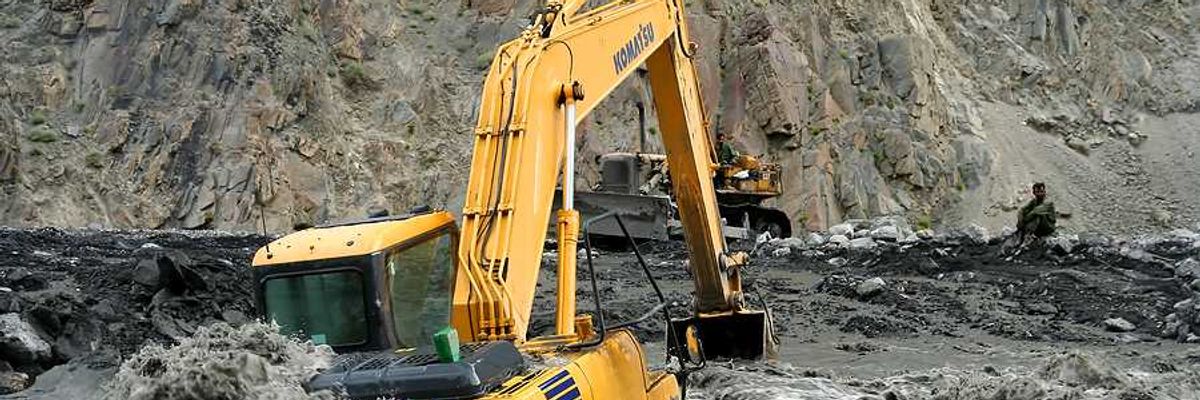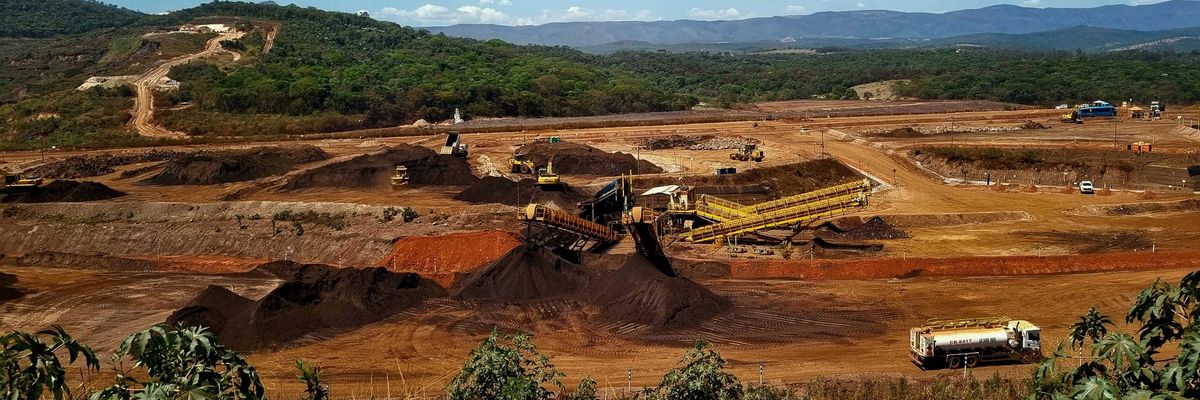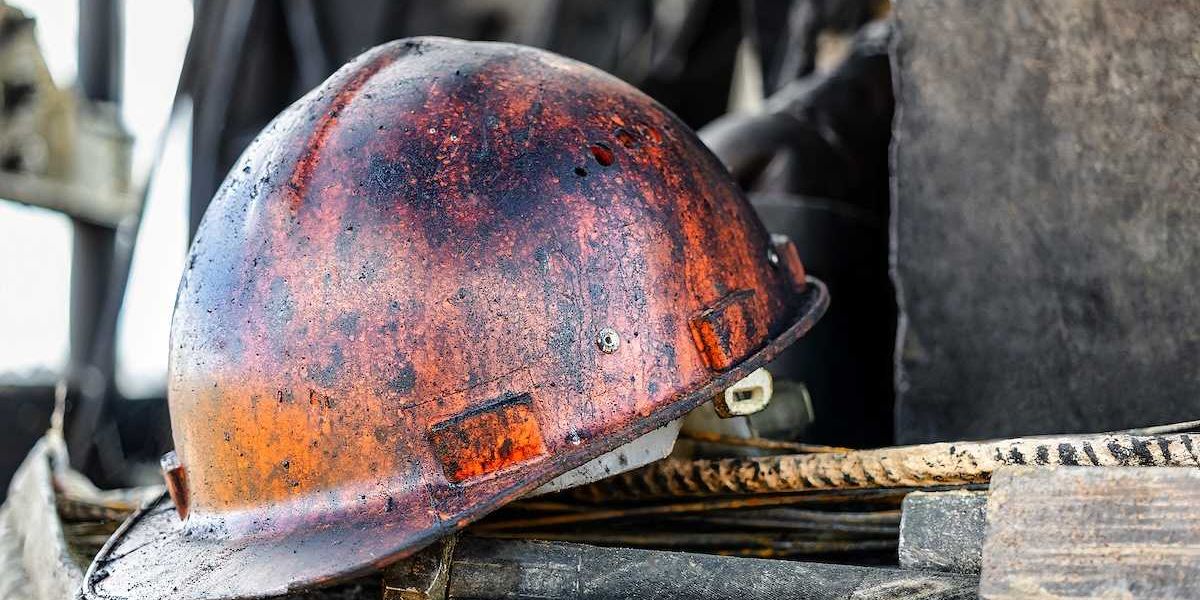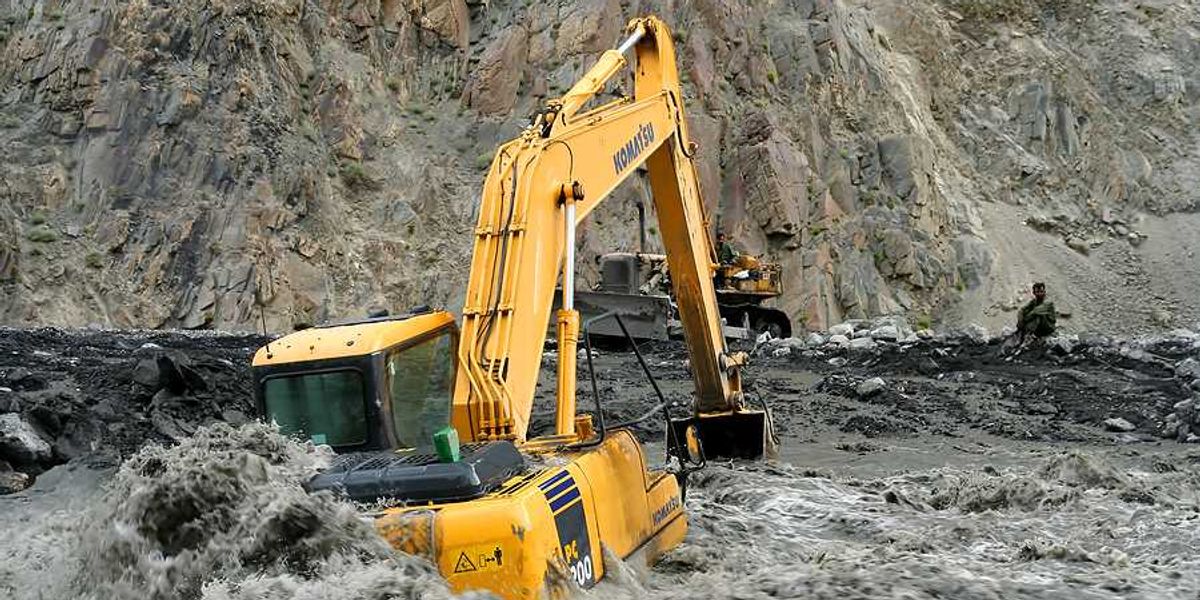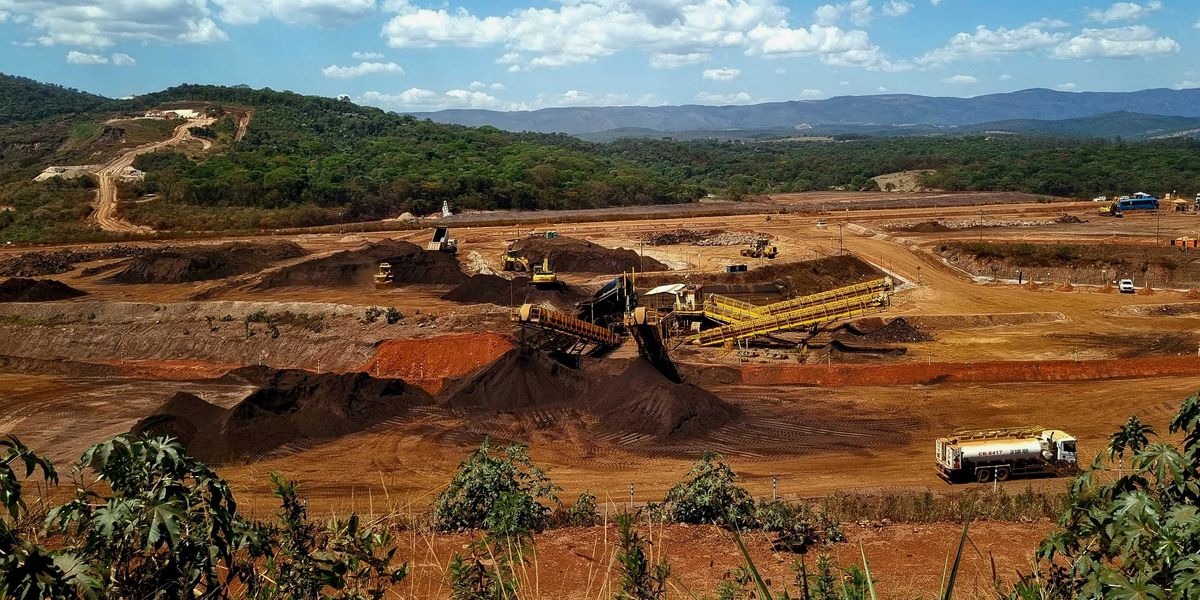air_ozone
Trump’s pro-coal agenda is a blow for clean air efforts at Texas' Big Bend park.
For decades Big Bend's stunning vistas have been compromised by poor air quality that Texas, working with the federal Environmental Protection Agency, is supposed to address.
Big Bend national park is Texas at its most cinematic, with soaring, jagged forest peaks looming over vast desert lowlands, at once haughty and humble, prickly and pretty. It is also among the most remote places in the state.
Even from Alpine, the town of 6,000 that is the main gateway to the park, it is more than an hour’s drive to one of the entrances.
So far from anywhere, it might seem an unlikely location to be scarred by air pollution. Yet for decades its stunning vistas have been compromised by poor air quality that Texas, working with the federal Environmental Protection Agency (EPA), is supposed to address.
But environmental advocates fear that the Trump administration’s pro-coal agenda will derail the prospects of improvement, at least in the short term. Tuesday’s announcement that the EPA plans to abandon the 2015 Clean Power Plan to reduce carbon emissions came less than two weeks after the agency revealed a revised plan to combat regional haze in Texas and Oklahoma that critics say will do little to cut pollution.
Chrissy Mann, Austin-based senior campaign representative with the Sierra Club’s Beyond Coal campaign, said: “Taken in combination with the Clean Power Plan, what we’re seeing is an attempt from this administration and this EPA to dig in their pockets and find whatever kind of tricks they think are going to stick to provide a lifeline to the coal industry across the country and here in Texas. It’s disappointing.”
Texas is part of a multi-state coalition that sued to stop the Clean Power Plan, which was placed on hold by the US supreme court last year.
Ken Paxton, the Texas attorney general, said in a statement: “It’s gratifying that our lawsuit against Obama-era federal overreach was a catalyst for repeal of the plan. We look forward to working with the administration to craft a new strategy that will protect the environment without hurting jobs and the economy.”
A back-and-forth between the EPA and Texas over regional haze has been in motion since 1999, when the agency launched a concerted effort to deal with the problem, bidding to improve the air quality in Big Bend national park, Guadalupe Mountains national park and in Oklahoma, the home state of the EPA administrator, Scott Pruitt.
In 2009, the state enforcer, the Texas Commission on Environmental Quality, issued a plan that would restore “natural visibility” to Big Bend by the year 2155. That was rejected as inadequate by the EPA in 2014.
The EPA wanted Texas to cut 230,000 tons of sulphur dioxide emissions per year to improve visibility and reduce the risk of worsening respiratory diseases and heart disease and damaging soil, water, fish and wildlife.
Two years later, finding “Texas relied on an analysis that obscured the benefits of potentially cost-effective controls”, the EPA replaced parts of Texas’s emissions plan, calling for plant upgrades and a target of “natural visibility” by 2064.
Texas sued the agency and won a stay of implementation in a federal appeals court. The state argued that it is making reasonable progress and, along with industry representatives, claimed that enacting the structural improvements – notably fitting some electricity plants with sulphur dioxide scrubbers – would cost $2bn and be a backdoor way of forcing the closure of coal-fired power plants. That, it said, might put the state at risk of power shortages and increased prices for consumers.
Last December, in the sunset days of the Obama administration, the EPA proposed another scheme that would also have required older plants to upgrade their technology.
But in August this year, Pruitt’s EPA asked a federal court for more time – until the end of 2018 – to come up with a way forward. When the judge refused, on 29 September the EPA unveiled a path that is much more palatable for Texas and the power companies: one that wouldn’t require retrofitting, instead claiming to achieve comparable results with an intrastate cap-and-trade programme. That would give polluters allowances within an overall emissions budget that can be used or traded in a marketplace.
Such programmes can be effective, but Mann, of the Sierra Club, contends that the cap is too high so will not provide any incentive for meaningful reductions. “It’s not very aggressive. In other words, the amount of pollution that coal plants in Texas are allowed to produce is actually higher than our emissions from last year from the same coal plants, taken all together,” Mann said.
The National Park Service and EPA carried out a study in 1999 to understand what causes haze in Big Bend, which is worse in the warmer months. It found that sulphate particles formed from sulphur dioxide sources such as coal power plants and refineries were a key cause.
Researchers discovered that substantial amounts of sulphate particulates came not only from Texas and Mexico, but the distant eastern US. When air flows from the east, production in America’s coal heartlands has an effect on Big Bend’s scenery.
Even if Trump’s efforts to boost coal collide with economic reality and market forces spur more growth in renewable energy, any delays in transitioning to cleaner energy and reduced emissions prolong the haze problem.
Air quality has not improved and ozone has seen a slight deterioration over the past decade, according to Jeffery Bennett, physical sciences program coordinator at the park. “Nitrogen deposition has not changed and remains a significant concern. Desert landscapes are especially sensitive to nitrogen,” he wrote in an email in July.
“Mercury is an emerging concern,” he added, based on levels found in fish; it is unclear whether this is because of atmospheric deposition or the legacy of nearby abandoned mercury mines.
The park faces Mexico and since Donald Trump entered the White House it has attracted attention as a particularly unsuitable place to build a wall.
Still, in a few years, tourists might find that while Trump might have failed to wall off the Big Bend from Mexico, the view is blocked all the same. “If you’re standing here in Panther Junction and not able to see the Sierra del Carmen that’s 20 miles away, because of the sulphates and other pollutions that blew in, you’re missing a big part of why this became a park,” Jennette Jurado, the park’s public information officer, said earlier this year at the main visitor centre.
Paris experiments with ‘car-free day’ across city.
Sunday marks the third time the French capital has experimented with a car ban, but it is by far the most ambitious with the zone set aside for pedestrians or cyclists covering the entire historic heart of the city - 105 square kilometres (40 square miles).
by Marie WOLFROM
Paris (AFP) | 1 October 2017 11:08
Sunday marks the third time the French capital has experimented with a car ban, but it is by far the most ambitious with the zone set aside for pedestrians or cyclists covering the entire historic heart of the city — 105 square kilometres (40 square miles).
“This initiative requires an enormous amount of preparation,” city mayor Anne Hidalgo told Le Parisien newspaper on Sunday. “Particularly because this year the zone has been enlarged to the whole of Paris.”
Hidalgo, a Socialist, was elected in 2014 promising to tackle pollution in the capital and she has focused on building new bus and cycle lanes and reclaiming roads — leading critics to see her agenda as too radical and anti-car.
“What’s it for?”, grumbled Pierre Chasseray, the head of the lobby group “40 million drivers” when asked about the car-free day by AFP. “It’s just PR to say that cars aren’t good.”
The restrictions came into force at 11:00 am local time (0900 GMT) and will last until 6:00 pm (1600 GMT).
Although billed officially as “The Day without Cars”, some exceptions apply, meaning the streets are not completely deserted: taxis, buses and emergency or social services vehicles are allowed to drive.
Residents who need to use their vehicle to visit an elderly or handicapped person or with a genuine emergency are also allowed to ply the streets, though they must respect a 30 kilometre an hour (20 miles an hour) speed limit in place.
Hundreds of police and city officials have been deployed to check on drivers, with fines for unauthorised driving ranging from 90-135 euros (105-159 dollars).
“The aim is simply to enjoy the city in a different way,” said Paris city transport official Christophe Najdovski on Friday. “It’s a day that is meant to be educational, fun and friendly.”
© 2017 AFP
Pollution fuelled layer over Asia that can create an ozone hole.
The atmospheric layer forms above India, China and the Middle East during the monsoon season and it believed to be intensifying because of pollution from India and China.
The atmospheric layer forms above India, China and the Middle East during the monsoon season and it believed to be intensifying because of pollution from India and China.
ENVIRONMENT Updated: Sep 13, 2017 10:40 IST
Malavika Vyawahare
Launch preparation,at the balloon facility of the Tata Institute of Fundamental Research in Hyderabad during more recent balloon measurement campaign in August.(Credit. Jean-Paul Vernier)
Scientists are now certain that a layer of aerosols that appears over Asia every monsoon season is pollution-fuelled, and can mess with the global climate.
The layer that appears between 13-18 kms above the earth’s surface is called the Asian Tropopause Aerosol Layer or ATAL. It forms in June and fades away by October.
“Modeling work carried out in our group suggests that the ATAL is indeed manmade with a strong contribution from Sulfur emission in Asia,” Jean-Paul Vernier, a scientist at NASA Langley Research Center, said.
The research, a collaboration by Indian, American and European scientists, into the recently discovered phenomena, shows that this layer is getting thicker. There has been an increase in particle concentration within the ATAL since the late 90’s following drastic increase in ground emissions in Asia over the same period of time.
The bad news is that some scientists believe this layer is capable of creating the kind of hole in the Earth’s ozone layer that currently exists over Antarctica.
“We believe that the ATAL could also deplete the lower part of the ozone layer in the tropics through chemistry similar to what happens in the polar region and lead to the ozone hole,” Vernier said. Researchers are looking for evidence that this has already occurred.
“Intensity of aerosol layer are usually measured as aerosol optical depth,” Harish Gadhavi, a scientist at the Physical Research Laboratory in Ahmedabad, explained. “In last 18 years layer’s aerosol optical thickness has increased from 0.002 to 0.006 which is a 3- fold increase.”
A thicker ATAL would block solar radiation and have an overall cooling effect on the temperature near the ground similar to what happens after a volcanic eruption, called the umbrella effect. It is unusual that the layer has appeared in the absence of any recent volcanic eruptions.
The ATAL could also interfere with the formation of cirrus clouds . Its impact on the monsoons is still being studied. In August, NASA and ISRO carried out a round of balloon measurements, that help validate data collected using satellites, and will shed more light on the composition and effects of this looming phenomenon.
“The presence of the ATAL is not only a regional issue but can have global implications since the tropics is the entrance door for air which spread through the stratosphere via the global atmospheric circulation,” Vernier said.
US EPA grants pollution waiver to Florida utilities after Irma.
State and federal environmental regulators issued a blanket waiver on Monday for Florida electricity companies to violate clean air and water standards without penalty for the next two weeks.
WASHINGTON — State and federal environmental regulators issued a blanket waiver on Monday for Florida electricity companies to violate clean air and water standards without penalty for the next two weeks.
The Environmental Protection Agency said the so-called No Action Assurance granted through Sept. 26 came at the request of the Florida Department of Environmental Protection. The letter said the move will provide Florida utility generators needed flexibility to maintain and restore electricity supplies in the wake of Hurricane Irma. The EPA said the move was in the public's interest.
Florida's Division of Emergency Management said about noon on Monday that 6.52 million utility customers in the state were without power. That's more than 65 percent of all electricity customers.
The EPA's assurance letter will allow utilities to operate outside restrictions mandated by their permits, including potentially using dirtier fuels, running for longer hours or electively bypassing pollution control equipment. Coal-fired plants can also discharge wastewater laced with levels of toxic-heavy metals at higher concentrations than what would normally be permitted.
The utilities are still required to monitor and report the levels of regulated contaminates in their air emissions and water discharges, according to the letter.
The Associated Press reported last week that air pollution levels spiked in the Houston area after a similar enforcement waiver was granted to Texas petrochemical facilities ahead of Hurricane Harvey's arrival.
___
Follow Associated Press environmental writer Michael Biesecker at https://www.Twitter.com/mbieseck
Northern China smog cuts life expectancy by 3 years versus south: Study.
Air pollution caused by coal-fired winter heating has slashed life expectancy in northern China by more than three years compared with the south, according to a new study, underlining the urgency of Beijing’s efforts to tackle smog.
SHANGHAI (Reuters) - Air pollution caused by coal-fired winter heating has slashed life expectancy in northern China by more than three years compared with the south, according to a new study, underlining the urgency of Beijing’s efforts to tackle smog.
Researchers with the Energy Policy Institute at the University of Chicago (EPIC) said average lifespans north of the Huai river, where China supplies mostly coal-fired winter heat, were 3.1 years lower than in the south, which is not covered by the state heating policy. EPIC’s study cites long-term smog exposure as a primary cause of the difference.
In a statement, EPIC said its study examined pollution and mortality data in 154 cities from 2004 to 2012, and found higher death rates were due entirely to increases in cardiorespiratory illnesses. EPIC didn’t give an absolute number for average life expectancy, but said its study was the first to focus on differences in air quality north and south of the Huai river.
“We know on highly polluted days more people die and more people are sick, but what this study helps to isolate are the consequences of long-run sustained exposure,” said Michael Greenstone, EPIC director and one of the report’s authors.
China is in the fourth year of a “war on pollution” designed to reverse the damage done by decades of untrammelled economic growth and allay concerns that hazardous smog and widespread water and soil contamination are causing hundreds of thousands of early deaths every year.
According to EPIC, if China were to comply with World Health Organization air quality standards, its people could live 3.5 years longer on average.
EPIC said its study was able to isolate the impact of air pollution on health in northern China versus the south.
Every 10 micrograms per cubic meter of additional long-term exposure to smog particles cuts life expectancy by 0.6 years, the study found.
Average readings of PM2.5 pollution - breathable airborne particles of less than 2.5 micrometers in diameter - stood at 45 micrograms per cubic meter in China from January to July, with the northern Beijing-Tianjin-Hebei region reaching 69 micrograms. The national standard is 35 micrograms.
Beijing has promised to impose tough industrial and traffic curbs this winter and is also in the process of shutting thousands of coal-fired boilers.
The government has acknowledged pollution is a health hazard but researchers have said more data was needed to understand its full effects, especially when it comes to the specific role it plays in diseases like lung cancer.
“We have enough evidence for the short-term effects of air pollution, but for long-term health, it is far from sufficient,” said Kan Haidong, professor at the School of Public Health at Fudan University in Shanghai, adding that the government has recently commissioned new studies. Kan wasn’t involved in the EPIC work but has worked on his own pollution studies.
“In the next five years, there is going to be more and more evidence linking air pollution with health in China,” he said.
Liberals struggling to reverse Harper's cuts to climate science in Canada.
Scientists are questioning whether the Trudeau government's funding decisions will result in science being served to the best it could be over the long term.
Liberals struggling to reverse Harper's cuts to climate science
By Carl Meyer in News | September 5th 2017
Environment and Climate Change Minister Catherine McKenna tells reporters at an Aug. 31 event in Gatineau. Que. that the Liberal government wants to recognize the “very important work” of scientists. Photo by Alex Tétreault
Five years ago, climate change scientists said they were in the midst of a severe funding crisis.
For more than decade, they had benefited from tens of millions of dollars in federal funding, which allowed Canada’s academic leaders to build a robust research network that pioneered significant breakthroughs. An independent organization, the Canadian Foundation for Climate and Atmospheric Sciences, evaluated their project proposals and allocated the federal dollars for a wide range of research topics.
It led to many groundbreaking studies across the country on drought, extreme weather, permafrost and more. But it was all about to end, because former prime minister Stephen Harper's government had decided to turn off the financial taps.
Scientists started speaking out.
In the face of mounting public pressure, Harper’s government introduced a new program with dedicated funding for climate change research, outside of federal departments, providing a temporary solution.
But now, with that money drying up, many scientists say it’s all happening again, putting several environmental monitoring programs, including those tracking key climate change indicators, in jeopardy.
Budgets for seven key independent projects are set to expire, including the Polar Environment Atmospheric Research Laboratory (PEARL) — arguably the most important Arctic research lab in the world.
“There does seem to be a strong element of history repeating itself here,” said James Drummond, a professor from the Department of Physics and Atmospheric Science at Dalhousie University in Halifax, who has led research at the Arctic lab.
“The PEARL facility nearly went under in 2013 — in fact, we were within a few weeks of starting the shutdown when we got new funding. The problem is now repeating itself, since we will run out of funding early in 2018 and there seems to be no prospect of any additional funding.”
Prime Minister Justin Trudeau’s Liberals swept into power in the 2015 election with a promise to put scientific evidence at the heart of government decisions. But despite the rhetoric from Liberals about paying attention to science and making climate change a key priority, the Trudeau government continues to struggle in its efforts to rebuild what was lost during the Harper era.
Even if PEARL gets new funding today, there will still be gaps in data, noted Katie Gibbs, executive director of Evidence For Democracy, a non-profit group that advocates for government decisions based on evidence.
Katie Gibbs, executive director of Evidence For Democracy, said the PEARL Arctic research lab, which is powered by funding about to expire at the end of the year, is a "one-of-a-kind research facility." Photo courtesy of Evidence For Democracy on Facebook
Canada's academics are still recovering
“It’s a one-of-a-kind research facility,” Gibbs told National Observer, speaking about PEARL. “It’s the most northern Arctic research centre studying atmospheric change in the world.
"So this is not just important to Canadian science, it’s absolutely important to global science and I think it also represents the role that Canadians science can play in international research, especially around arctic science and arctic issues.”
Even so, she said, gaps in the data are still preferable to no data, and Evidence For Democracy would still like to see new funding announced immediately.
Kimberly Strong, a physics professor at the University of Toronto who has worked at PEARL validating data for a satellite ozone monitoring instrument, also said it will take another year to get a program in place.
That's in addition to the lead time between the announcement of any funding program and actually getting calls out for proposals, she said — not to mention getting peer review in place, and other typical steps in the funding process for research.
Thomas Pedersen, a professor from the school of earth and ocean sciences at the University of Victoria, intimately knows what research is now in jeopardy.
He's the chairman of the Canadian Climate Forum, which emerged from the ashes of the Canadian Foundation for Climate and Atmospheric Sciences after it was starved of its funding between 2012 and 2013. He said the Harper government’s funding choices “resulted in a decline in climate-research support of nearly 50 per cent nationwide.”
The academic community has yet to recover, he added, despite the Trudeau government “being much more progressive in facing the immense climate change challenge.”
“As a nation, we must do better in supporting research on the physics of our changing planetary climate, on adapting to what will be — and already is — a different future, and reaching out more vigorously to Canadians to make the case that dealing with the climate challenge presents us with immense new-economy opportunities.”
The PEARL lab in 2008. Christos Zerefos, president of the International Ozone Commission, said there are “uncomfortable feelings” in the ozone scientific community about the future of the polar ozone research program. PEARL photo
Scientists want long-term commitment
As PEARL and other environmental monitoring projects face their potential demise, Canada plays host this week to a prestigious gathering of the Intergovernmental Panel on Climate Change (IPCC), featuring scientists and government officials from around the world.
And later in the month, the world will celebrate the 30th anniversary of the Montreal Protocol, a monumental treaty that changed the course of history by shifting humanity’s damage to the ozone layer into reverse gear.
Environment and Climate Change Minister Catherine McKenna, who will open the IPCC conference this week in Montreal, said in an interview that the Liberal government wants to recognize the “very important work” of scientists in government as well as in academic institutions.
“It has been a top priority of mine to ensure that we have capacity, that we are rebuilding capacity of our scientists that we’re working with other groups, with other organizations, and that's certainly been a key priority," she said Aug. 31, after unveiling a new website designed to engage children on climate change.
"I spent a lot of time in the Arctic this summer, where we’re seeing the impacts of climate change. We opened a new laboratory, research station, in the high Arctic. We need to understand better the impacts of climate change there, and the acceleration of climate change, and I’m working with my colleagues across government.”
Gibbs of Evidence For Democracy has noted that the new federal Arctic lab, announced by the Harper government, is 1,200 kilometres south of PEARL and won’t be able to do the same level of monitoring and research.
All in all, many scientists, contacted by National Observer for this article said the government was missing a key issue: creating a stable environment for long-term research. Public and private sector scientists in Canada and researchers abroad say what’s needed now is long-term monitoring of the protective ozone layer in the upper atmosphere, as well as the smog-inducing ozone near the surface.
“You need to look at the ozone layer for 10, 20 years,” said Wolfgang Steinbrecht, a scientist at Germany's national meteorological service who did his doctorate in Toronto and worked at PEARL.
“Canada is playing a part, but it could play a bigger part," he added. "That will take a long-term commitment.”
The climate forum, Pedersen said, has also recognized that “outreach efforts nationally must be strengthened,” but he said “realizing them will require support, and that remains an unfilled need.”
Thomas Duck. Photo from Thomas Duck
Thomas Duck, an associate professor in Dalhousie's physics and atmospheric science department, said “it boggles the mind that the federal government would consider ending funding” for PEARL. National Observer file photo
Ending funds for Arctic lab 'boggles the mind'
Ottawa has not yet announced that funding for the Climate Change and Atmospheric Research (CCAR) program, which supports PEARL and six other projects, will be renewed after it runs out at the end of the year.
Personnel at the lab are already looking elsewhere for work, and money has been set aside to help with the logistics of closing up shop, said University of Toronto's Strong.
“CCAR is really what’s funding most of the science,” she said. “It’s not clear where people can go to keep the funding going for these projects... we’re certainly not getting any indications that there’s a delayed announcement, or there will be an announcement.”
Officials point to other funds set up by the government, and say researchers are free to apply to those, but it’s unclear how quickly that money can start flowing.
“Right now we’re taking measurements as normal, but sometime next year, we’ve got a little bit of money put aside to shut things down, and if there’s nothing to keep us going” the lab will find it hard to stay open, she said.
The situation is leading a string of prominent scientists to raise concerns. Christos Zerefos, president of the International Ozone Commission, said there are “uncomfortable feelings” in the scientific community studying ozone.
“We have strongly supported... that the Canadian government should continue funding the polar ozone research program,” he told National Observer.
Environment and Climate Change Canada scientist David Tarasick, who has spent over 30 years in the department, also called the move surprising. The CCAR programs, he said, “gave quite a boost to atmospheric science.”
"There doesn’t seem to be anything in the wings right now," he said in an interview. "That kind of surprises me, because usually, something else comes along. Otherwise, how do you fund all the people who are halfway through their careers?"
Thomas Duck, an associate professor in Dalhousie's physics and atmospheric science department, said “it boggles the mind that the federal government would consider ending funding” for PEARL.
“This represents a lot of lost scientific capacity, which impedes scientific progress,” he said, adding the end of CCAR will be “devastating.”
"PEARL is definitely not something that everybody has," added Steinbrecht. "If I was the minister, I would say, 'This is something where we’re strong, so let’s stay strong in that.'"
Science Minister Kirsty Duncan's office says the Trudeau government is “taking a comprehensive approach" to addressing climate change, "including significant investments" in research. Photo by Alex Tétreault
New centre 'not intended to replace' climate fund
Trudeau has appointed an award-winning scientist to his cabinet, after winning the 2015 election to address issues like these.
But the office of Trudeau’s point person on ensuring evidence-based decisions, Science Minister Kirsty Duncan, declined an interview with National Observer for this story.
An official from the ministers office, speaking on background, said the government understands that "the most up-to-date evidence is necessary to mitigate the harmful effects of climate change,” and is “taking a comprehensive approach to addressing this important issue, including significant investments in climate change research across government."
The official pointed to the most recent federal budget’s announcement of $73.5 million for a new Canadian Centre for Climate Services — part of a $260-million pot to implement government commitments on adaptation and climate resilience.
But that new climate services program was "not intended to replace" the program running out of money, confirmed Marissa Harfouche, a spokeswoman for Canada’s federal environment department, which will administer the new program.
"The details of the CCCS are not yet finalized. However, the planned focus of this centre is not research, but rather the sharing of climate-related information," she explained.
Harfouche said the centre will instead "work with provincial, territorial, Indigenous and other partners to make it easier for governments, communities, decision-makers, businesses and organizations to access data and information on climate science, and help support climate adaptation decision-making across the country."
The official in Duncan's office also noted the government's $40-million commitment to the National Research Council to "integrate climate resilience into building codes that will help prepare communities for the effects of climate change." Investments like that, the official said, "serve as proof of our government's commitment to addressing the threat posed by climate change in a concrete and comprehensive way."
Duncan’s press secretary, Ann Marie Paquet, also pointed out that Duncan has two upcoming science-related announcements in British Columbia this week: one connected with a hydrogen radio telescope, and another on the Natural Sciences and Engineering Research Council’s Discovery (NSERC) Discovery Grants Program, which Paquet called “the biggest science funding announcement of the year.”
“We are a government that believes in science and evidence, and we are certainly seeing clear signs that the planet is warming at a rate that is very concerning and that we all need to be working together,” Environment Minister Catherine McKenna told National Observer last week. She is seen here at a federal government announcement on Aug. 31, 2017. Photo by Alex Tétreault
NSERC says researchers can compete for fresh funding elsewhere
Lucy Lai, media and public affairs officer for NSERC, which has been running the expiring climate fund, said researchers supported by its dollars can compete for fresh funding through NSERC’s “existing suite of programs, many of which support climate science research.”
Two NSERC programs Lai pointed to are the Discovery grants, which Duncan will be announcing this week, and its Strategic Partnership grants. In addition, she said, the Networks of Centres of Excellence of Canada is hosting a funding competition that is open until Nov. 15.
The organization has four networks that support environmental research: ArcticNet at Université Laval; the Green Aviation Research and Development Network in Montreal; the Marine Environmental, Observation, Prediction and Response Network at Dalhousie University; and the Ocean Networks Canada Innovation Centre in Victoria.
ArcticNet’s current funding began in 2003 and appears to be wrapping up next year, according to NSERC’s website. Current funding for the centre in Victoria began in 2009 and also ends next year, the website indicates, while the green aviation network's funding has been running from 2009 and ends in two years. The Dalhousie centre's current batch of funding is set to run out in 2021.
Based on what its ministers are saying publicly, there’s no doubt that the Trudeau government understands the importance of research projects like these.
“We are a government that believes in science and evidence, and we are certainly seeing clear signs that the planet is warming at a rate that is very concerning and that we all need to be working together,” McKenna told National Observer last week.
“That’s scientists from across the globe, and Canadian scientists, and scientists from all the countries around the world, making sure that we have good science and that we’re making those decisions based on science, and that we’re all working together to really understand the impacts of climate change. We’re seeing extreme weather events, floods, hurricanes, droughts, all over the world. So we all need to be working together.”
National Observer also asked NSERC for a list of government programs outside their council that CCAR scientists can apply for.
In response, NSERC suggested a “sampling” of other government programs that Lai said, “may provide CCAR scientists with alternative funding opportunities” — as long as those scientists are eligible to apply and were competitive candidates.
These programs are the following: a climate change geoscience program at Natural Resources Canada; funded projects at Fisheries and Oceans Canada on oceans and freshwater; a greenhouse gases program and research initiatives at Agricultural and Agri-Food Canada; POLAR Knowledge Canada science and technology research projects; and funding programs at Environment and Climate Change Canada.
Environment Minister Catherine McKenna said an international ozone monitoring conference in Geneva, Switzerland this spring went off without any “negative feedback” for Canada. Photo by Alex Tétreault
Long-term data questioned at another initiative
National Observer reported last month on another example of long-term data that scientists say may be in jeopardy.
Tarasick, the Environment Canada scientist, gave advice to his superiors in 2015 recommending that an ozone monitoring station closed during the Harper era be re-opened. The Liberals say that's still being considered two years later.
That station and another remain closed, and other management changes remain in place, despite Trudeau personally attacking the Conservatives over those decisions when in opposition.
That means long-term data isn’t getting collected, said Tarasick. “It’s a real problem for the scientific community,” he said. Tarasick has recently published peer-reviewed research that made use of earlier data from the stations that were shut down.
“It’s really important to have stable funding, [so] that they can invest in themselves without always looking over their shoulder to where the next meal may be coming from,” he said.
It’s all too familiar for Steinbrecht, who has seen the PEARL lab stopped and started again due to the end of the climate and atmospheric sciences foundation.
“They usually have a program, they pour in a lot of money, they have a grad student do something for two or three years, and then when that is used up, that’s it,” he explained. “That happened when we were there, and it’s happened two or three times in the meantime.”
Meanwhile, Canada continues to tout the lab in international circles. In a presentation to an international ozone monitoring conference in Geneva, Switzerland this spring, Canada’s report labelled the funding-plagued polar lab as a “very well-used and equipped facility.”
McKenna's office has said that this meeting went off without any “negative feedback” for Canada.
However, the meeting did result in one recommendation suggesting that Canada could improve monitoring by submitting more data of UV radiation on a timely basis. This type of data is collected using a type of monitoring device invented by Canadians, called Brewer spectrophotometers.
Everybody has resource constraints, said Environment Canada’s Tarasick.
"My impression overall is that, since we essentially solved the ozone depletion issue with the Montreal Protocol, there isn’t the same level of public interest, and there isn’t the same level of funding and consequence.”
Drummond, the scientist from Dalhousie University, said Canada has a long way to go to catch up to the rest of the world.
“I am in South Africa at the moment in a major conference on atmospheric issues," he said, "and I have to say that Canada is not very present at this conference. I can only look on with envy at research programs in Europe, Asia, Africa, and South America — to say nothing of the United States, which put our programs to shame."
— with files from Mike De Souza
Pollution levels in Bolivia plummet on nationwide car-free day.
Air pollution levels have plunged in cities across Bolivia as the country marked a nationwide car-free day in which all non-emergency vehicles were banned from city streets.
Air pollution levels have plunged in cities across Bolivia as the country marked a nationwide car-free day in which all non-emergency vehicles were banned from city streets.
As Bolivia’s middle-class population has increased over the past 10 years so has the number of cars clogging city streets. The car-free event started 18 years ago in Cochabamba, one of Latin America’s five most polluted cities, and has gradually taken root across the country. By 2011, it had become so popular that Bolivia’s legislature declared a yearly “Day of the Pedestrian and Cyclist in Defence of Mother Earth”.
“Air pollution drops by 60-70% because 70% of our air contaminants come from vehicles,” said Soledad Delgadillo of Cochabamba’s municipal government. “The difference in air quality is noticeable. It [pollution] drops to almost zero when normally it can rise as high as 100 parts per cubic metre,” said Jorge Martin Villarroel, director of the environmental charity PAAC.
Cochabamba now has three pedestrian days a year, including the national day, while Bolivia’s highland city of Potosí recently set up four.
In Bolivia’s capital city, La Paz, the 2017 pedestrian day was also used to promote participation in sports. “We have so many blockades and demonstrations, we want to encourage a positive citizen takeover of the streets,” said Jessica Nieto from the city’s government.
“Pedestrian day complements the zebras who defend walkers’ rights,” she said. The zebras are young people named after pedestrian crossings who are hired to dress as the animals and calm traffic in the free-for-all that is La Paz.
As 70% of Bolivia’s urban workforce are employed informally, vendors of every kind flood the streets in cities nationwide on pedestrian day. “Our biggest problem is the spike in consumption of drinks and food packaged in plastic bags and disposable containers,” Delgadillo said.
Families love it. Jesus Romero, who lives on the northern edge of Cochabamba, said: “We really enjoy that it is so quiet and peaceful without any cars around, and that’s there’s space in the streets for the kids to play.”
Deyanira López, 14, highlighted another benefit. “Our city is very beautiful but you just don’t see it because of all the cars,” she said.
“It gives us a great opportunity to do environmental education about climate change and protecting the environment, as people enjoy it so very much,” Delgadillo said.
Last Friday Cochabamba inaugurated its second bike- and pedestrian-only path. “Our plans for the future include turning part of the downtown into a pedestrian-only area, and hopefully acquiring a citywide public bike system like other cities have,” said Villarroel.
Increasing bicycle use is a priority. “We worked with the municipality to get a law passed promoting bicycles, pulling together over 1,000 signatures in support it,” said Villarroel. “We have managed to unite people who ride bikes into quite a lobby to pressure the city and get bike lanes and routes set up.”
“I’ve been riding a bike for 30 years but I can’t do it any more because it’s just gotten too dangerous,” said Jesus Romero. “Today we get a rest from the car contamination, which is so toxic for all of us.”
Andres Clares, 16, agreed, saying: “I really like walking at least one day without cars. It’s quieter and the air is so much fresher.” In a typically noisy city, the sudden silence is striking.
This year the event’s catchphrase is “leave your green footprint in Cochabamba”. Six eco-stations are focused on different themes in coordination with local businesses and charities. “These educate about the air, animals, water, recycling, protected areas and trees,” said Gaviota Borda, head of the municipal department of environmental protection.
The sports focus in La Paz is inspired by the worldwide challenge day, which began in Saskatoon, Canada, in 1983 after a particularly brutal winter, when the mayor challenged residents to do 15 minutes of exercise together on the last Wednesday in May. Over 50 other communities accepted the challenge – and more than 650.000 people took part. By May 2017, world challenge day had grown to more than 50 million participants in over 20 countries.
“We want to reclaim physical activity in an age when young people are so focused on computers and technological entertainment,” said Nieto. In April this year, La Paz adopted a second annual car-free day. “Pedestrian day is intimately connected with expanding citizens’ rights.”

